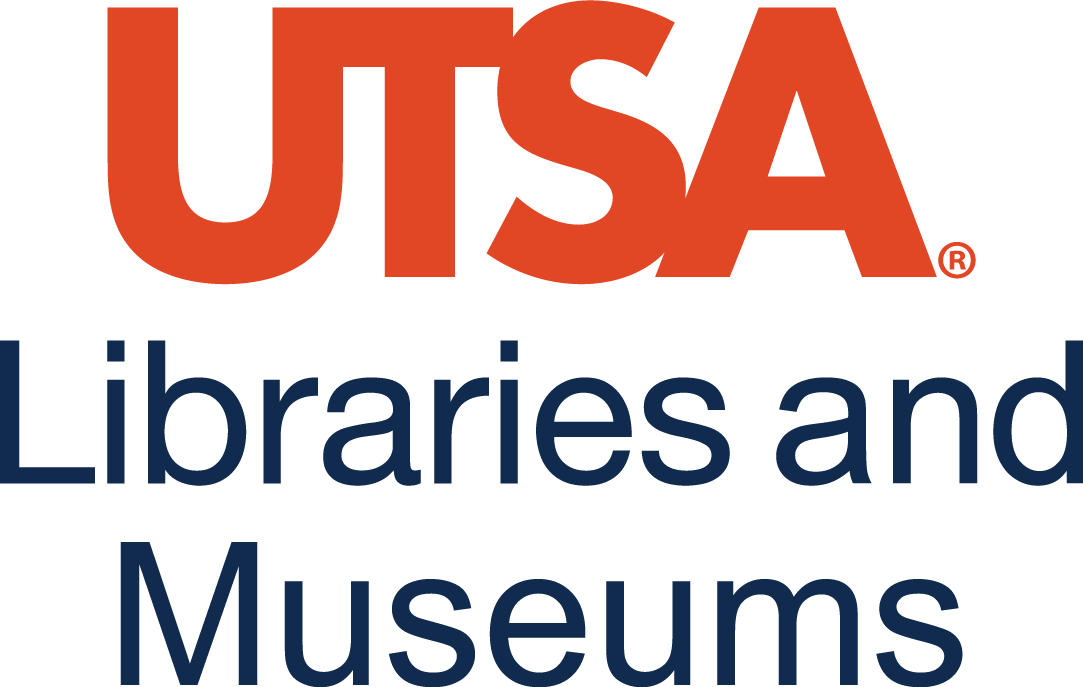3 Decimals:
Topics Covered[1]
In case you missed something in class, or just want to review a specific topic covered in this Module, here is a list of topics covered:
Name Decimals[2]
You probably already know quite a bit about decimals based on your experience with money. Suppose you buy a sandwich and a bottle of water for lunch. If the sandwich costs $3.45, the bottle of water costs $1.25, and the total sales tax is $0.33, what is the total cost of your lunch?
 The total is $5.03. Suppose you pay with a $5 bill and 3 pennies. Should you wait for change? No, $5 and 3 pennies is the same as $5.03.
The total is $5.03. Suppose you pay with a $5 bill and 3 pennies. Should you wait for change? No, $5 and 3 pennies is the same as $5.03.
Because 100 pennies = $1, each penny is worth ![]() of a dollar. We write the value of one penny as $0.01, since 0.01 =
of a dollar. We write the value of one penny as $0.01, since 0.01 =![]() .
.
Writing a number with a decimal is known as decimal notation. It is a way of showing parts of a whole when the whole is a power of ten. In other words, decimals are another way of writing fractions whose denominators are powers of ten. Just as the counting numbers are based on powers of ten, decimals are based on powers of ten. Table below shows the counting numbers.
| Counting Number | Name |
|---|---|
| 1 | One |
| 10 = 10 | Ten |
| 10 · 10 = 100 | One hundred |
| 10 · 10 · 10 = 1000 | One thousand |
| 10 · 10 · 10 · 10 = 10,000 | Ten thousand |
How are decimals related to fractions? Table below shows the relation.
| Decimal | Fraction | Name |
|---|---|---|
| 0.1 | One tenth | |
| 0.01 | One hundredth | |
| 0.001 | One thousandth | |
| 0.0001 | One ten-thousandth |
When we name a whole number, the name corresponds to the place value based on the powers of ten. In Numbers, we learned to read 10,000 as ten thousand. Likewise, the names of the decimal places correspond to their fraction values. Notice how the place value names in the table below relate to the names of the fractions from table above.
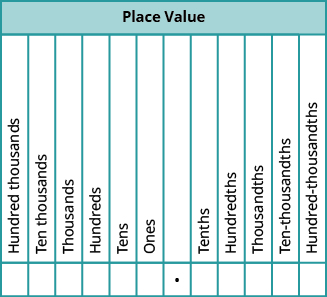
Notice two important facts shown in the table.
- The “th” at the end of the name means the number is a fraction. “One thousand” is a number larger than one, but “one thousandth” is a number smaller than one.
- The tenths place is the first place to the right of the decimal, but the tens place is two places to the left of the decimal.
Remember that $5.03 lunch? We read $5.03 as five dollars and three cents. Naming decimals (those that don’t represent money) is done in a similar way. We read the number 5.03 as five and three hundredths.
We sometimes need to translate a number written in decimal notation into words. As shown in the picture below, we write the amount on a check in both words and numbers.
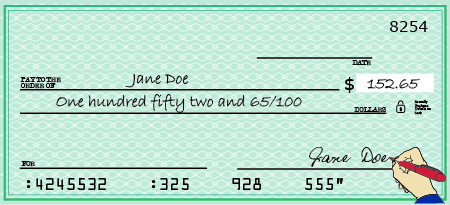
| Steps | Written |
| Let’s try naming a decimal, such as 15.68. | 15.68 |
| We start by naming the number to the left of the decimal. | fifteen______ |
| We use the word “and” to indicate the decimal point. | fifteen and_____ |
| Then we name the number to the right of the decimal point as if it were a whole number. | fifteen and sixty-eight_____ |
| Last, name the decimal place of the last digit. | fifteen and sixty-eight hundredths |
|
The number 15.68 is read fifteen and sixty-eight hundredths. |
|
How To:
- Name the number to the left of the decimal point.
- Write “and” for the decimal point.
- Name the “number” part to the right of the decimal point as if it were a whole number.
- Name the decimal place of the last digit.
Try it! – Naming Decimal Numbers
Name each decimal:
a. 4.3
b. 2.45
c. 0.009
d. −15.571.
| Steps |
Algebraic |
| 4.3 | |
| Name the number to the left of the decimal point. | four_____ |
| Write “and” for the decimal point. | four and_____ |
| Name the number to the right of the decimal point as if it were a whole number. | four and three_____ |
| Name the decimal place of the last digit. | four and three tenths |
b.
| Steps |
Algebraic |
| 2.45 | |
| Name the number to the left of the decimal point. | two_____ |
| Write “and” for the decimal point. | two and_____ |
| Name the number to the right of the decimal point as if it were a whole number. | two and forty-five_____ |
| Name the decimal place of the last digit. | two and forty-five hundredths |
c.
| Steps |
Algebraic |
| 0.009 | |
| Name the number to the left of the decimal point. | Zero is the number to the left of the decimal; it is not included in the name. |
| Name the number to the right of the decimal point as if it were a whole number. | nine_____ |
| Name the decimal place of the last digit. | nine thousandths |
d.
| Steps |
Algebraic |
| −15.571 | |
| Name the number to the left of the decimal point. | negative fifteen |
| Write “and” for the decimal point. | negative fifteen and_____ |
| Name the number to the right of the decimal point as if it were a whole number. | negative fifteen and five hundred seventy-one_____ |
| Name the decimal place of the last digit. | negative fifteen and five hundred seventy-one thousandths |
Write Decimals[3]
Now we will translate the name of a decimal number into decimal notation. We will reverse the procedure we just used.
Let’s start by writing the number six and seventeen hundredths:
| xxx | xxx |
| six and seventeen hundredths | |
| The word and tells us to place a decimal point. | ___.___ |
| The word before and is the whole number; write it to the left of the decimal point. | 6._____ |
| The decimal part is seventeen hundredths. Mark two places to the right of the decimal point for hundredths. |
6._ _ |
| Write the numerals for seventeen in the places marked. | 6.17 |
Try it! – Writing Decimal Numbers
Write fourteen and thirty-seven hundredths as a decimal.
| Steps | Algebraic |
| fourteen and thirty-seven hundredths | |
| Place a decimal point under the word ‘and’. | ______. _________ |
| Translate the words before ‘and’ into the whole number and place it to the left of the decimal point. | 14. _________ |
| Mark two places to the right of the decimal point for “hundredths”. | 14.__ __ |
| Translate the words after “and” and write the number to the right of the decimal point. | 14.37 |
| Fourteen and thirty-seven hundredths is written 14.37. |
How To:
- Look for the word “and”—it locates the decimal point.
- Mark the number of decimal places needed to the right of the decimal point by noting the place value indicated by the last word.
- Place a decimal point under the word “and.” Translate the words before “and” into the whole number and place it to the left of the decimal point.
- If there is no “and,” write a “0” with a decimal point to its right.
- Translate the words after “and” into the number to the right of the decimal point. Write the number in the spaces—putting the final digit in the last place.
- Fill in zeros for place holders as needed.
The second bullet in Step 2 is needed for decimals that have no whole number part, like ‘nine thousandths’. We recognize them by the words that indicate the place value after the decimal – such as ‘tenths’ or ‘hundredths.’ Since there is no whole number, there is no ‘and.’ We start by placing a zero to the left of the decimal and continue by filling in the numbers to the right, as we did above.
Try it! – Writing Decimal Numbers
Write twenty-four thousandths as a decimal.
| Steps | Algrebraic |
| twenty-four thousandths | |
| Look for the word “and”. | There is no “and” so start with 0 0. |
| To the right of the decimal point, put three decimal places for thousandths. |  |
| Write the number 24 with the 4 in the thousandths place. |  |
| Put zeros as placeholders in the remaining decimal places. | 0.024 |
| So, twenty-four thousandths is written 0.024 |
Before we move on to our next objective, think about money again. We know that $1 is the same as $1.00. The way we write $1(or$1.00) depends on the context. In the same way, integers can be written as decimals with as many zeros as needed to the right of the decimal.
Round Decimals[4]
In the United States, gasoline prices are usually written with the decimal part as thousandths of a dollar. For example, a gas station might post the price of unleaded gas at $3.279 per gallon. But if you were to buy exactly one gallon of gas at this price, you would pay $3.28, because the final price would be rounded to the nearest cent. In Whole Numbers, we saw that we round numbers to get an approximate value when the exact value is not needed. Suppose we wanted to round $2.72 to the nearest dollar. Is it closer to $2 or to $3? What if we wanted to round $2.72 to the nearest ten cents; is it closer to $2.70 or to $2.80? The number lines in the picture below can help us answer those questions.

Can we round decimals without number lines? Yes! We use a method based on the one we used to round whole numbers.
How To:
- Locate the given place value and mark it with an arrow.
- Underline the digit to the right of the given place value.
- Is this digit greater than or equal to 5?
- Yes – add 1 to the digit in the given place value.
- No – do not change the digit in the given place value
- Rewrite the number, removing all digits to the right of the given place value.
Try it! – Rounding Decimals
Round 18.379 to the nearest hundredth.
| Steps | Algebraic |
 |
|
| Locate the hundredths place and mark it with an arrow. |  |
| Underline the digit to the right of the 7. |  |
| Because 9 is greater than or equal to 5, add 1 to the 7. |  |
| Rewrite the number, deleting all digits to the right of the hundredths place. |  |
| 18.38 is 18.379 rounded to the nearest hundredth. |
Try it! – Rounding Decimals
Round 18.379 to the nearest
a. tenth
b. whole number.
Solution
| Steps | Algebraic |
| a. Round 18.379 to the nearest tenth. | |
 |
|
| Locate the tenths place and mark it with an arrow. |  |
| Underline the digit to the right of the tenths digit. |  |
| Because 7 is greater than or equal to 5, add 1 to the 3. |  |
| Rewrite the number, deleting all digits to the right of the tenths place. |  |
| So, 18.379 rounded to the nearest tenth is 18.4. |
| Steps | Algebraic |
| b. Round 18.379 to the nearest whole number. | |
 |
|
| Locate the ones place and mark it with an arrow. |  |
| Underline the digit to the right of the ones place. |  |
| Since 3 is not greater than or equal to 5, do not add 1 to the 8. |  |
| Rewrite the number, deleting all digits to the right of the ones place. |  |
| So 18.379 rounded to the nearest whole number is 18. |
Repeating Decimals[5]
So far, in all the examples converting fractions to decimals the division resulted in a remainder of zero. This is not always the case. Let’s see what happens when we convert the fraction 43 to a decimal. First, notice that 43 is an improper fraction. Its value is greater than 1. The equivalent decimal will also be greater than 1.
We divide 4 by 3.

No matter how many more zeros we write, there will always be a remainder of 1, and the threes in the quotient will go on forever. The number 1.333… is called a repeating decimal. Remember that the “…” means that the pattern repeats.
Repeating Decimal
A repeating decimal is a decimal in which the last digit or group of digits repeats endlessly.
How do you know how many ‘repeats’ to write? Instead of writing 1.333… we use a shorthand notation by placing a line over the digits that repeat. The repeating decimal 1.333… is written 1.3–. The line above the 3 tells you that the 3 repeats endlessly. So 1.333…=1.3–
For other decimals, two or more digits might repeat. The table below shows some more examples of repeating decimals.
| Example | Answer |
| 1.333…= |
3 is the repeating digit |
| 4.1666…= |
6 is the repeating digit |
| 4.161616…= |
16 is the repeating digit |
| 0.271271271…= |
271 is the repeating digit |
Try it! – Writing a Repeating Decimal
Write ![]() as a decimal.
as a decimal.
Solution
Divide 43 by 22.

Notice that the differences of 120 and 100 repeat, so there is a repeat in the digits of the quotient; 54 will repeat endlessly. The first decimal place in the quotient, 9, is not part of the pattern. So,
![]() =
= ![]()
It is useful to convert between fractions and decimals when we need to add or subtract numbers in different forms. To add a fraction and a decimal, for example, we would need to either convert the fraction to a decimal or the decimal to a fraction.
Try it! – Adding a Fraction and a Decimal
Simplify: ![]()
| xxx | xxx | xxx |
| Change 78 to a decimal. |  |
0.875+6.4 |
| Add. | 7.275 |
Decimal Operations[6]
How To:
- Write the numbers vertically so the decimal points line up.
- Use zeros as place holders, as needed.
- Add or subtract the numbers as if they were whole numbers. Then place the decimal in the answer under the decimal points in the given numbers.
Try it! – Adding Decimals
Add: 23.5 + 41.38.
| xxx | xxx |
| 23.5 + 41.38 | |
| Write the numbers vertically so the decimal points line up. |  |
| Place 0 as a place holder after the 5 in 23.5, so that both numbers have two decimal places. |  |
| Add the numbers as if they were whole numbers. Then place the decimal in the answer under the decimal points in the given numbers. |  |
How To:
- Determine the sign of the product.
- Write the numbers in vertical format, lining up the numbers on the right.
- Multiply the numbers as if they were whole numbers, temporarily ignoring the decimal points.
- Place the decimal point. The number of decimal places in the product is the sum of the number of decimal places in the factors. If needed, use zeros as placeholders.
- Write the product with the appropriate sign.
Try it! – Multiplying Decimals
Multiply: (3.9)(4.075).
Solution
| xxx | xxx |
| (3.9)(4.075) | |
| Determine the sign of the product. The signs are the same. | The product will be positive. |
| Write the numbers in vertical format, lining up the numbers on the right. |  |
| Multiply the numbers as if they were whole numbers, temporarily ignoring the decimal points. | 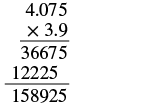 |
| Place the decimal point. Add the number of decimal places in the factors (1+3). Place the decimal point 4 places from the right. | 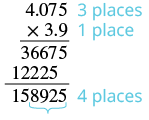 |
| The product is positive. | (3.9)(4.075) = 15.8925 |
Convert Decimals to Fractions or Mixed Numbers[7]
We often need to rewrite decimals as fractions or mixed numbers. Let’s go back to our lunch order to see how we can convert decimal numbers to fractions. We know that $5.03 means 5 dollars and 3 cents. Since there are 100 cents in one dollar, 3 cents means ![]() of a dollar, so 0.03 =
of a dollar, so 0.03 = ![]() .
.
We convert decimals to fractions by identifying the place value of the farthest right digit. In the decimal 0.03, the 3 is in the hundredths place, so 100 is the denominator of the fraction equivalent to 0.03.
For our $5.03 lunch, we can write the decimal 5.03 as a mixed number.
Notice that when the number to the left of the decimal is zero, we get a proper fraction. When the number to the left of the decimal is not zero, we get a mixed number.
How To:
- Look at the number to the left of the decimal.
- If it is zero, the decimal converts to a proper fraction.
- If it is not zero, the decimal converts to a mixed number.
- Write the whole number.
- Determine the place value of the final digit.
- Write the fraction.
- numerator—the ‘numbers’ to the right of the decimal point
- denominator—the place value corresponding to the final digit
- Simplify the fraction, if possible.
Try it! – Convert a Decimal Number to a Fraction or Mixed Number
Write each of the following decimal numbers as a fraction or a mixed number:
a. 4.09
b. 3.7
c. −0.286
Solution
| Steps | Algebraic |
| a. | |
| 4.09 | |
| There is a 4 to the left of the decimal point. Write “4” as the whole number part of the mixed number. |
 |
| Determine the place value of the final digit. |  |
| Write the fraction. Write 9 in the numerator as it is the number to the right of the decimal point. |
 |
| Write 100 in the denominator as the place value of the final digit, 9, is hundredth. |  |
| The fraction is in simplest form. |  |
Did you notice that the number of zeros in the denominator is the same as the number of decimal places?
| xxx |
xxx |
| b. | |
| 3.7 | |
| There is a 3 to the left of the decimal point. Write “3” as the whole number part of the mixed number. |
 |
| Determine the place value of the final digit. |  |
| Write the fraction. Write 7 in the numerator as it is the number to the right of the decimal point. |
 |
| Write 10 in the denominator as the place value of the final digit, 7, is tenths. |  |
| The fraction is in simplest form. |  |
| xxx |
xxx |
| c. | |
| −0.286 | |
| There is a 0 to the left of the decimal point. Write a negative sign before the fraction. |
 |
| Determine the place value of the final digit and write it in the denominator. |  |
| Write the fraction. Write 286 in the numerator as it is the number to the right of the decimal point. Write 1,000 in the denominator as the place value of the final digit, 6, is thousandths. |
 |
| We remove a common factor of 2 to simplify the fraction. |  |
Key Concepts
- Decimal place values

-
- Name a decimal number.
- Name the number to the left of the decimal point.
- Write “and” for the decimal point.
- Name the “number” part to the right of the decimal point as if it were a whole number.
- Name the decimal place of the last digit.
- Name a decimal number.
- Write a decimal number from its name.
- Look for the word “and”—it locates the decimal point.
Place a decimal point under the word “and.” Translate the words before “and” into the whole number and place it to the left of the decimal point.
If there is no “and,” write a “0” with a decimal point to its right. - Mark the number of decimal places needed to the right of the decimal point by noting the place value indicated by the last word.
- Translate the words after “and” into the number to the right of the decimal point. Write the number in the spaces—putting the final digit in the last place.
- Fill in zeros for place holders as needed.
- Look for the word “and”—it locates the decimal point.
- Round a decimal.
- Locate the given place value and mark it with an arrow.
- Underline the digit to the right of the given place value.
- Is this digit greater than or equal to 5?
Yes – add 1 to the digit in the given place value.
No – do not change the digit in the given place value - Rewrite the number, removing all digits to the right of the given place value.
- Convert a decimal number to a fraction or mixed number.
- Look at the number to the left of the decimal.
If it is zero, the decimal converts to a proper fraction.
If it is not zero, the decimal converts to a mixed number.
Write the whole number. - Determine the place value of the final digit.
- Write the fraction.
numerator—the ‘numbers’ to the right of the decimal point
denominator—the place value corresponding to the final digit - Simplify the fraction, if possible.
- Look at the number to the left of the decimal.
- Add or Subtract Decimals
- Write the numbers vertically so the decimal points line up.
- Use zeros as place holders, as needed.
- Add or subtract the numbers as if they were whole numbers. Then place the decimal in the answer under the decimal points in the given numbers.
- Multiplying Decimal Numbers
- Determine the sign of the product.
- Write the numbers in vertical format, lining up the numbers on the right.
- Multiply the numbers as if they were whole numbers, temporarily ignoring the decimal points.
- Place the decimal point. The number of decimal places in the product is the sum of the number of decimal places in the factors. If needed, use zeros as placeholders.
- Write the product with the appropriate sign.
- Divide a decimal by a whole number.
- Write as a long division, placing the decimal point in the quotient above the decimal point in the dividend.
- Divide as usual.
- Divide decimal numbers.
- Determine the sign of the quotient.
- Make the divisor a whole number by moving the decimal point all the way to the right. Move the decimal point in the dividend to the same number of places to the right, writing zeros as needed.
- Divide. Place the decimal point in the quotient above the decimal point in the dividend.
- Write the quotient with the appropriate sign.
- Access for free at https://openstax.org/books/prealgebra-2e/pages/1-introduction ↵
- Section material derived from Openstax Prealgebra: Introduction to Decimals ↵
- Section material derived from Openstax Prealgebra: Introduction to Decimals-Decimals ↵
- Section material derived from Openstax Prealgebra: Introduction to Decimals-Decimals ↵
- Section material derived from Openstax Prealgebra: Introduction to Decimals-Decimal Operations ↵
- Section material derived from Openstax Prealgebra: Introduction to Decimas-Decimal Operations ↵
- Section material derived from Openstax Prealgebra Introduction to Decimals-Decimals ↵
A number line is used to visualize numbers. The numbers on the number line get larger as they go from left to right, and smaller as they go from right to left.
a decimal in which the last digit or group of digits repeats endlessly
